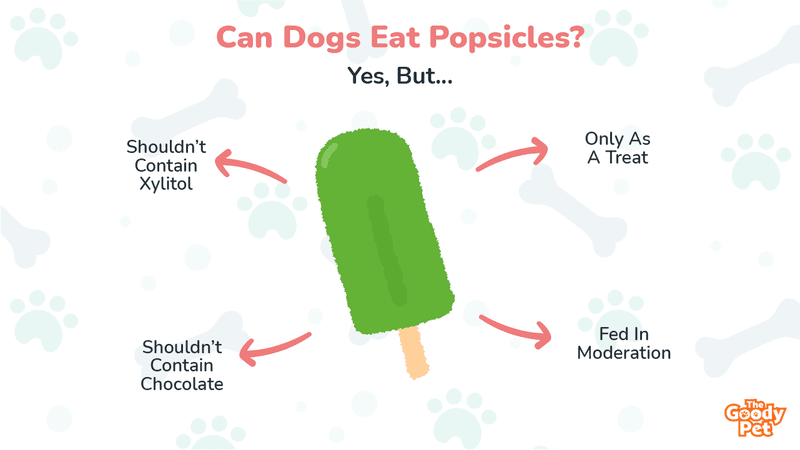Frozen popsicles, apart from being incredibly tasty, can be a human lifesaver on hot, sunny days. And often, having to deal with a pooch’s imploring eyes while enjoying this tasty snack on a stick has led to many wondering whether or not dogs can safely eat popsicles.
Dogs can safely eat popsicles as long as they are not prepared with human ingredients such as xylitol and chocolate that can be toxic to canines. Additionally, to prevent the development of gastrointestinal issues, popsicles should be fed to dogs in moderation.
One of the reasons for the extreme popularity of popsicles among humans is the variety of flavors and tastes that this snack typically comes in, and your canine buddy can also enjoy this variety as well. This article contains a brief guide to preparing frozen popsicles for your pooch, as well as the benefits of offering this frozen treat to your canine buddy.
Feeding popsicles to dogs also comes with its own risks, and these are also well outlined in this article. However, before we go further, let’s see why and when popsicles are considered safe for dogs to eat.
Can Dogs Eat Popsicles?
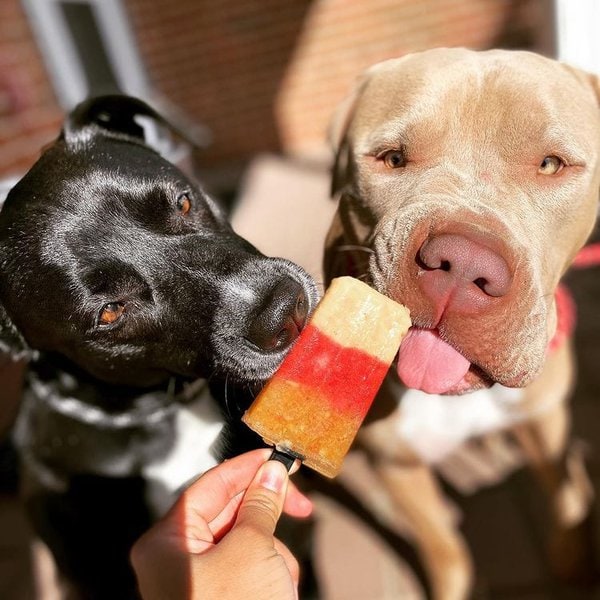
Yes, dogs can indeed eat popsicles, provided they are prepared with non-toxic ingredients that are safe for canine consumption and fed in moderation to the pooch.
Popsicles are liquid-based, frozen snacks typically placed on a stick, and the characteristic great taste, flavor, and attractive colors of this snack have secured its status as a human favorite over the years.
Popsicles have also slowly found their way into the canine diet, and nowadays, it is a common sight to see a pooch being fed with this tasty treat.
That said, dogs can safely eat frozen popsicles, provided they weren’t originally made for human consumption. Human-grade popsicles typically contain ingredients that, if consumed by dogs, can result in a myriad of health issues for the Fido.
If you must feed your dog with frozen popsicles, ensure to only go for products that are specifically formulated for canine consumption.
How Many Frozen Popsicles Can My Dog Eat?
Popsicles should not constitute the main part of a dog’s diet, and to get the most of the snack, it is advisable that you feed it to your canine buddy only as a treat. And when feeding dogs with treats such as frozen popsicles, it is recommended that you stick to the 10% rule.
Summarily, this rule states that ‘treats being fed to a dog shouldn’t make up more than 10% of the dog’s total daily caloric intake’. Consequently, if you’re to feed a dog with frozen popsicles, you’re to ensure that this frozen treat doesn’t constitute more than the stipulated amount of your dog’s daily calories due to its low nutritional content.
Frozen popsicles aren’t difficult to prepare. And with the right set of equipment and ingredients, you can prepare and feed this tasty treat to your canine buddy right from the comfort of your home. If you’re willing to put in the effort to prepare frozen popsicles for your dog at home, the next section containing a vet-approved frozen treat recipe for the tasty popsicle is for you.
How Can I Prepare Popsicles For My Dog To Eat?
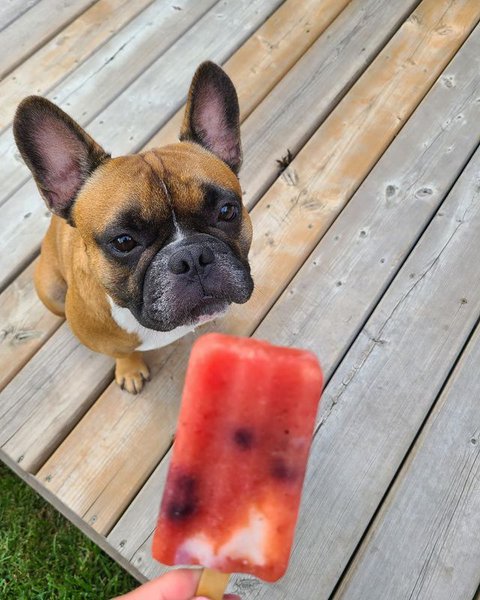
Homemade popsicles for dogs are typically prepared by blending together natural fruit sugars from fruit with limited ingredients and subsequently freezing the resulting mixture for preservation.
We’ve mentioned earlier that popsicles made for human consumption aren’t safe for dogs to eat due to the presence of ingredients that can be potentially harmful to dogs.
Thankfully, there is a safe, dog-friendly recipe available for those looking to treat their pooches with these tasty popsicles without exposing their canine buddies to toxic ingredients.
Ingredients And Equipment Needed To Prepare Dog-Friendly Frozen Popsicles
- Base food ingredient – this could be dog-friendly fruits such as watermelons, bananas, or strawberries, vegetables such as pumpkins, yogurt, or xylitol-free peanut butter.
- Plastic popsicle molds – as much as possible, avoid molds that contain wooden or plastic sticks, as these pose a choking hazard to dogs.
- Mixing bowl
- Blender
How To Prepare Dog-Friendly Frozen Popsicles
- Regardless of whatever base ingredient you go for, the first step in preparing frozen popsicles for dogs typically involves mixing two or three of these ingredients together (yogurt is almost always present as a liquid base)
- Once the ingredients have been proportionally mixed, they are subsequently blended together to create a paste.
- The paste is subsequently transferred into popsicle molds and allowed to freeze for between 3 to 4 hours.
- Once frozen, the popsicle can then be removed from its mold and offered to the pooch.
What Are The Benefits Of Feeding My Dog With Frozen Popsicles?
Feeding a dog with frozen popsicles can help keep the pooch cool during hot temperatures, and a popsicle can also be used as a treat to reward and encourage good behavior by a dog.
Popsicles Help Keep Dogs Cool
Feeding your dog with frozen popsicles is a healthy way of keeping your Fido cool on a hot summer afternoon. Frozen popsicles can help to safely drop your pooch’s body temperature, thereby helping them to cool down and preventing issues such as heat stroke from developing.
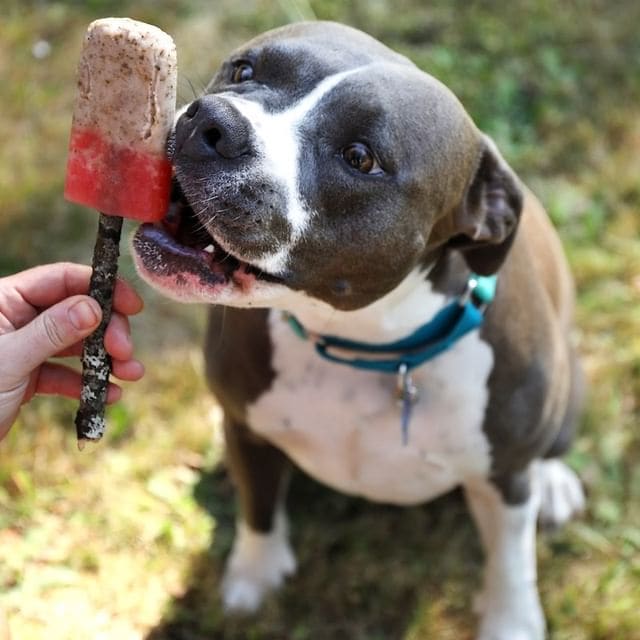
Popsicles Make A Great Treat For Dogs
If you are looking for a way to reward and positively reinforce good behavior in your dog, then popsicles can come in handy as a healthy treat.
Additionally, feeding frozen popsicles is a great way to provide your pooch with mental enrichment due to the challenge involved in breaking through the ice to get to the popsicle. And if you’re looking for a way to keep a dog busy, feeding the pooch in question with a frozen popsicle is a great place to start.
Can Popsicles Be Bad For Dogs?
Consumption of popsicles prepared with ingredients such as xylitol and chocolate can be toxic and often life-threatening to dogs. Additionally, feeding a dog with popsicles can result in the pooch suffering stomach upsets and digestion issues.
Xylitol Poisoning
Some companies make use of a sugar substitute, xylitol, in preparing their dog popsicles, and this substance can be extremely harmful to dogs, even when consumed in the smallest amounts.
Consumption of xylitol by dogs usually results in a drastic drop in a pooch’s blood sugar level, which typically induces symptoms such as vomiting, lethargy, incoordination, and weakness, among others.
Xylitol poisoning in dogs is dangerous because symptoms of hypoglycemia typically appear within 10 to 60 minutes after consumption, and if not promptly attended to, this condition can be life-threatening to a dog.
Consequently, and to ensure that your canine buddy isn’t at risk of suffering xylitol poisoning from the consumption of popsicles containing xylitol, it is imperative that you thoroughly check the product label to ensure that it doesn’t contain this harmful substance.
Even better, you can prepare popsicles for your dog at home using the recipe we provided earlier. By doing this, you have complete knowledge of the ingredients used in preparing the popsicles for your dog, thereby avoiding the inclusion of harmful substances such as xylitol.
Chocolate Poisoning
Apart from the use of xylitol, some brands also make use of chocolate to prepare their popsicles, and when consumed, this can be very toxic to a pooch.
Chocolate contains a compound, namely theobromine, and it is known to induce symptoms such as vomiting, seizures, changes in blood pressure, extreme weakness, excessive thirst, and even coma in dogs.
As is applicable with xylitol, chocolate poisoning, which arises from feeding a pooch with popsicles containing this substance, can be avoided by inspecting the list of ingredients used in preparing the treat before feeding it to the pooch.
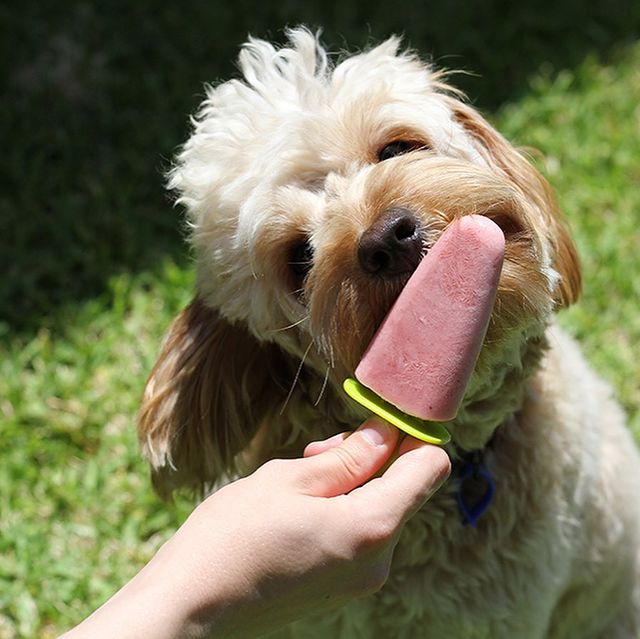
Gastrointestinal Upset
Many popsicles contain dairy products such as ice cream or yogurt, and even if fed to dogs in small quantities, there’s every chance of such popsicles triggering abdominal discomfort, bloating, vomiting, and diarrhea in dogs.
Additionally, some dogs are lactose-intolerant and may experience difficulties digesting popsicles that are prepared with dairy products, such as yogurt and milk.
Weight-Related Issues
Even if the sugar and sweeteners contained in popsicles pose no problem for your canine buddy, feeding a pooch with excessive amounts of popsicles can result in the development of weight-related issues such as obesity.
Similarly, feeding popsicles to a diabetic pooch can worsen such a dog’s condition and result in joint issues.

